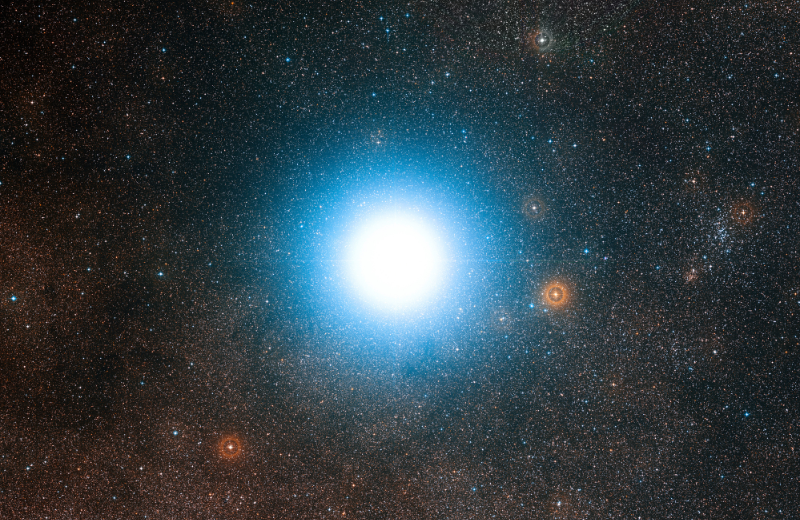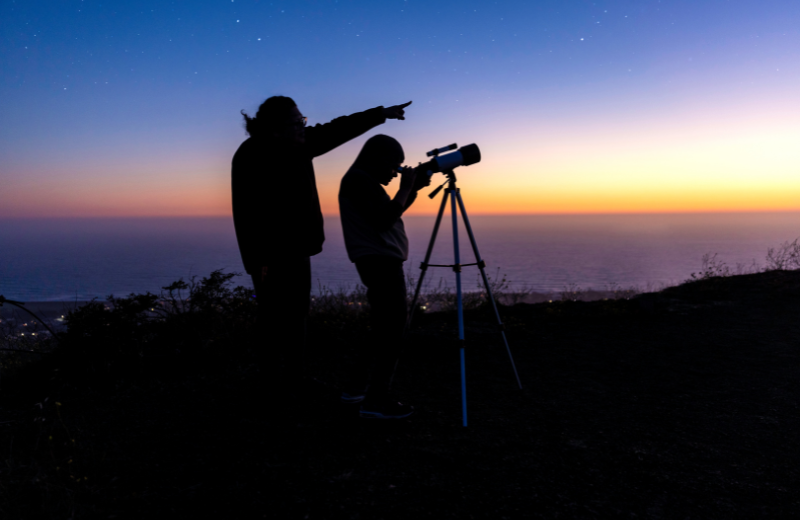Antlia, also known as the "Air Pump" constellation, is one of the lesser-known constellations in the southern sky. By the end of this guide, you'll know how to find Antlia in the sky and be familiar with its unique features, mythology, and much more.
Jump to:
- What is the Antlia Constellation?
- What Does Antlia Look Like?
- The Antlia Constellation Myth
- What Does the Antlia Constellation Symbolise?
- What Galaxy is Antlia In?
- How to Pronounce Antlia
- Antlia's Stars
- Nebulae in the Antlia Constellation
- Finding Antlia in the Sky
- Fun Facts About Antlia
- Study Astronomy for £29
Recommended for you!
Best SellersWhat is the Antlia Constellation?
Antlia is a small constellation located in the southern hemisphere. Unlike some of the more prominent constellations, Antlia might not be as well-known, but it still holds its charm and significance. Its name, derived from the Latin word for "air pump," reflects the object it was named after. Antlia was introduced in the 18th century and represents an air pump, specifically one that was used in early pneumatic experiments.
Despite its small size, Antlia has intrigued astronomers and stargazers due to its unique stars and the deep-sky objects it contains. It may not have the bright, easily recognisable stars of Orion or Ursa Major, but Antlia offers its own quiet beauty and scientific interest.
What Does Antlia Look Like?

The Antlia constellation is somewhat faint and challenging to spot without a clear, dark sky. It doesn't have any very bright stars, so it's not the easiest constellation to find for beginners. Antlia is composed of several stars that form a simple, almost rectangular shape. This lack of prominent stars means you’ll need a bit of patience and possibly some binoculars or a telescope to see it clearly.
The Antlia Constellation Myth
Unlike many constellations, Antlia doesn't have a rich mythology dating back to ancient times. In fact, Antlia is a relatively modern addition to the night sky. It was introduced by the French astronomer Nicolas-Louis de Lacaille in the 18th century. Lacaille was responsible for naming several constellations after scientific instruments, reflecting the spirit of discovery and invention during the Enlightenment.
As Antlia was named after an air pump, it doesn't carry the same mythological stories as constellations like Orion or Perseus. Instead, Antlia symbolises the progress of science and human curiosity, commemorating the tools that have helped us explore and understand the world around us.
What Does the Antlia Constellation Symbolise?

The meaning of the Antlia constellation is closely tied to its name and origins. Representing an air pump, Antlia symbolises the spirit of innovation and scientific exploration. During the 18th century, when Antlia was named, there was a great emphasis on scientific discovery. Instruments like the air pump were crucial in advancing our understanding of physics and the natural world.
In a broader sense, Antlia can be seen as a reminder of the importance of curiosity and the pursuit of knowledge. While it may not be as glamorous or storied as other constellations, Antlia's symbolism is deeply connected to the progress of science.
What Galaxy is Antlia In?
Antlia is a part of our own Milky Way galaxy. Within the Antlia constellation, astronomers have discovered several interesting deep-sky objects, including galaxies and nebulae.
One of the most notable is the Antlia Cluster, a group of galaxies located about 133 million light-years from Earth. This cluster is one of the most prominent features within the constellation and has been a subject of study for astronomers interested in galaxy formation and behaviour.
How to Pronounce Antlia
"Antlia" is pronounced as "ANT-lee-uh." It’s a straightforward pronunciation once you get the hang of it.
Antlia's Stars

While Antlia may not boast any particularly bright stars, it does have a few noteworthy ones:
- Alpha Antliae: The brightest star in the constellation, Alpha Antliae is a red giant located about 320 light-years away from Earth. Despite being the brightest in Antlia, it's still relatively faint compared to stars in other constellations.
- Epsilon Antliae: Another interesting star in Antlia, Epsilon Antliae, is a binary star system. This means that what appears as a single star is actually two stars orbiting each other. Binary stars are fascinating to astronomers as they can provide insights into stellar formation and evolution.
- Iota Antliae: Iota Antliae is a white giant star, located approximately 190 light-years away from earth. It’s another example of the diverse types of stars that can be found within this small constellation.
Nebulae in the Antlia Constellation
In addition to its stars, Antlia is home to some intriguing nebulae and deep-sky objects:
- The Antlia Dwarf Galaxy: This is a small, faint galaxy located within the constellation. It's a member of the Local Group, which includes our own Milky Way galaxy. The Antlia Dwarf Galaxy is relatively close in astronomical terms, at about 4.3 million light-years away, and it's one of the faintest galaxies known.
- NGC 2997: This is a face-on spiral galaxy that lies on the border of Antlia and the neighbouring constellation Pyxis. NGC 2997 is known for its well-defined spiral arms and active star-forming regions, making it a beautiful object to observe through a telescope.
Finding Antlia in the Sky

Antlia is a faint constellation located in the southern hemisphere, making it a rewarding but challenging target for stargazers. Due to its relatively dim stars, observing Antlia requires a location with minimal light pollution and a keen eye, especially if you’re new to stargazing. Here’s how you can find Antlia and explore its celestial features.
Locating the Antlia Constellation
Finding Antlia begins with identifying its neighbouring constellations, as it doesn’t have any particularly bright stars of its own. The key to locating Antlia is to first find the surrounding constellations, such as Hydra or Vela, which are more prominent in the night sky.
- Find Hydra or Vela: Start by locating Hydra, the largest constellation in the sky, or Vela, which is part of the larger Argo Navis constellation. Both are much easier to spot and will serve as good reference points.
- Look for Antlia's Faint Stars: Once you've identified these constellations, look towards the region of the sky where they border each other. Antlia’s stars form a simple, rectangular shape, but they are faint, so it may take a few moments to adjust your eyes or equipment to spot them clearly.
Viewing Antlia with Binoculars or a Telescope
Given Antlia's faint stars, using binoculars or a telescope can significantly enhance your viewing experience, allowing you to trace its delicate outline more effectively.
- With Binoculars: Binoculars can help you see the stars of Antlia more distinctly, especially in areas with slight light pollution. They will make it easier to discern the constellation's rectangular shape and pick out stars that might otherwise be invisible to the naked eye.
- With a Telescope: A small to medium telescope can bring Antlia's stars into clearer view. While the constellation doesn’t boast many bright stars, a telescope will allow you to explore its faint stars and potentially some of its deep-sky objects, such as the Antlia Dwarf Galaxy or the spiral galaxy NGC 2997.
The Best Viewing Times
Antlia is best observed during the autumn and winter months in the southern hemisphere, when it is positioned high in the sky. This time of year offers clearer, darker skies, which are ideal for spotting this subtle constellation. If you're in the northern hemisphere, you'll need to look towards the southern horizon during these months, although Antlia will be much lower in the sky and harder to spot.
Special Features to Observe
While Antlia may not be as rich in deep-sky objects as some other constellations, it does contain a few notable features:
- Alpha Antliae: The brightest star in Antlia, a red giant that stands out slightly more than the other stars in the constellation.
- The Antlia Dwarf Galaxy: A faint galaxy that belongs to the Local Group, which includes the Milky Way. It's one of the more intriguing deep-sky objects in this constellation.
- NGC 2997: A face-on spiral galaxy located on the border of Antlia and Pyxis, known for its well-defined spiral arms and star-forming regions.
Recommended for you!
Best SellersFun Facts About Antlia
Here are a few fun facts about the Antlia constellation that you might find interesting:
- One of the Newer Constellations: Antlia was one of the 14 constellations introduced by Nicolas-Louis de Lacaille in the 18th century, making it one of the newer additions to the night sky.
- Named After an Air Pump: The constellation's name reflects the air pump, a device used in scientific experiments, particularly those involving vacuums and pneumatics.
- Home to the Antlia Cluster: This cluster of galaxies is one of the most distant objects associated with the Antlia constellation, lying about 133 million light-years away.
- Best Viewed from the Southern Hemisphere: While Antlia is located in the southern sky, it can be seen from some parts of the Northern Hemisphere, although it’s much more prominent in the Southern Hemisphere.
Study Astronomy for £29
If you’re fascinated by the stars and want to learn more about the universe, consider enrolling in our Astronomy Diploma Course at Centre of Excellence. You’ll gain a detailed understanding of the stars, planets, and celestial phenomena, all from the comfort of your own home. Sign up today for a discounted price of £29 and start your journey into the cosmos!













